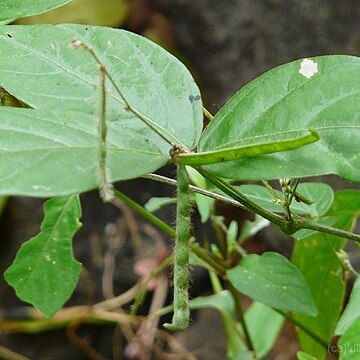Twining vines, mostly pubescent. Leaves pinnate trifoliolate, the leaflets mostly broadly or narrowly ovate, mucronate; stipels subulate; stipules narrow, striate. Inflorescences axillary racemes; peduncles slender, often elongate, sev-eral flowered; bracteoles 2, subtending the calyx or just below the top of the pedicel; pedicels short, pubescent. Flowers inconspicuous; calyx tubular, lobed about 1/2 way down, the lobes subulate, subequal or the upper pair fused and longer; standard emarginate, glabrous, exserted slightly from the upper calyx lobes; stamens pseudomonadelphous, the alternating anthers reduced and sterile; ovary linear, pubescent, the style incurved, glabrous, the stigma capitate. Le-gume linear, mostly straight, sometimes compressed, with a small but prominent often upturned beak, mostly pubescent, explosively dehiscent by 2 valves; seeds numerous, separated by valvular tissue, plump, lenticular.
Perennial twining herbs. Leaves pinnately 3-foliolate; stipules and stipels deciduous. Flowers small, in axillary clusters or racemes; bracts small, linear, persistent; bracteoles linear, longitudinally striate. Calyx membranous, campanulate, 4-or 5-lobed. Corolla slightly exserted; standard obovate, narrow at base, clawed, without auricles; wings narrow, adnate to blunt, straight, and shorter keel. Stamens monadelphous, only 5 longer developed, 5 shorter sterile or lacking. Ovary sessile, many ovuled; style short, curved, glabrous; stigma capitate. Legumes linear, flattened, persistent style base forming upcurved beak at apex, sometimes transversely impressed between seeds. Seeds numerous.
Ovary sessile, many-ovuled, linear, often with a tuft of hairs at the apex surrounding the style; style short, thick, glabrous, with a capitate stigma.
Vexillary stamen free or joined to the others; 5 anthers normally developed, alternate anthers poorly developed or lacking.
Flowers paired or in clusters in the axils, or more commonly paired or clustered along axillary axes.
Corolla small; standard obovate to rounded, glabrous apart from occasional hairs around the centre.
Seeds oblong, ovoid or subglobose, with a short hilum and sometimes a thin rim aril.
Leaves pinnately (or subdigitately 3-foliolate); stipels and stipules present.
Pod linear; style base accrescent, forming a right-angled hook at the apex.
Trailing or climbing perennial herbs, rarely subshrubs.
Calyx 5-lobed, the upper two lobes united or not.

